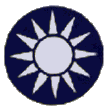China

Lieutenant Wang Yin-Hua
China

Lieutenant Wang Yin-Hua
At the start of the Sino-Japanese war, Lieutenant Wang Yin-Hua was serving in the 23rd PS of the 4th PG. This unit was at the time equipped with Curtiss Hawk IIIs.
During the night of 14 and 15 August the pilots of the 4th PG at Schien-Chiao airbase had to prepare their fighters themselves since the ground personnel had left the field to take shelter during the air raid on 14 August and had not returned. The pilots carried cans of fuel on their backs from the storage building to the field, punched holes on the cans and fuelled the aircraft themselves. They had not eaten since noon, and were not able to go to bed until 1:30 a.m. They did not sleep long because alarm sounded less than two hours later.
In the early morning on 15 August Colonel Kao Chi-Hang led 21 Hawk III's from the 4th PG to intercept a dawn attack on Hangchow by twelve Type 89 torpedo bombers from the Japanese carrier Kaga. In the confused action in and out of clouds, the 4th PG made 17 claims, more than the total number of Japanese planes in the action. The actual losses were six shot down and two ditched in Hangchow Bay.
Kao quickly shot down one of the Type 89's on the edge of the formation and then attacked another setting it alight. A lucky shot from the starboard quarter hit Kao in the right arm before passing through the instrument panel and damaging the engine in his Hawk No. IV-1. He was forced to land at Schien-Chiao and was out of action for 2 months.
21st PS's Squadron Leader Captain Lee Kuei-Tan in No. 2101 attacked the No. 2 Shotai, shooting down the No. 2 plane over Chao-Er. Two out of the crew of three were seen to bail out but they were over the Chao-Er River and probably did not survive. Lee then teamed up with Lieutenant Cheng Hsiao-Yu of 22nd PS in No. 2202 to claim another Type 89. Return fire from the tightly packed Japanese formation was heavy and Lee's No. 2101 received slight damage to its upper wings while Cheng’s No. 2202 took a shot in one of its landing wheels. Cheng’s wingman, 2nd Lieutenant Chang Kuang-Ming also claimed a victory in this combat when he attacked the leader of a group of Japanese bombers. He opened fire with his two machine guns. Tracers and bullets truck his target, and the enemy plane turned into a fireball and plunged out of the sky. He broke off immediately and turned around for another strike.
Lieutenant Huang Yan-Po in No. 2107 attacked the first Shotai, claiming to have shot down the No. 3 aircraft in flames. He too took a shot in the landing wheel. Lieutenant Tan Won in No. 2104 also attacked the same Shotai and claimed another Type 89. This may have been the aircraft of the Kaga's Commander, Air Group (CAG) Commander Iwai who was killed in this action along with his deputy. Lieutenant Wang Wen-Hua caught two Type 89's trying to attack Schien-chiao from the south and shot one down in flames. One of the crew, a young ensign, bailed out and was captured. (This unnamed ensign later defected to the Chinese side and helped translate decoded Japanese radio messages). Lieutenant Yuan Chin-Han in No. 2108 went after the No.1 Shotai in a formation and claimed to have shot down the leader in flames (this may also have been Iwai's plane, it is almost certain that many Chinese pilots shot at the same planes). Lieutenant Liu Chi-Sheng in No. 2102 also claimed one Type 89 over Woong-Chia-Fu but was hit in the fuel tank and force landed at Chaio-Shi Airfield where his plane was further damaged by bombing.
Lieutenant Le Yi-Chin from the 22nd PS made no less than 4 claims but these are almost certainly duplicates of other claims or overoptimistic.
Deputy Squadron C.O. Lai Ming-Tang landed to refuel and took off again to claim a shared kill with his wingman Lieutenant Liang Tian-Cheng.
Of the 23rd PS, Captain Mao Ying-Chu, Lieutenant Yang Yu-Ching and Lieutenant Wang Yin-Hua each claimed one Type 89.
In the end of August 1942 Wang served as commander of the 29th PS (Polikarpov I-16s) when seven aircraft from this unit led by him was re-based to Lanzhou for defence of this city and airfield.
Wang Yin-Hua ended the war with 1 biplane victory, this one being claimed while flying the Curtiss Hawk III.
Claims:
| Kill no. | Date | Number | Type | Result | Plane type | Serial no. | Locality | Unit |
| 1937 | ||||||||
| 1 | 15/08/37 | 1 | Type 89 (a) | Destroyed | Curtiss Hawk III | Hangchow area | 23rd PS |
Biplane victories: 1 destroyed.
TOTAL: 1 destroyed.
(a) Claimed in combat with Type 89 torpedo bombers from the Japanese carrier Kaga. The Chinese pilots claimed 17 destroyed enemy aircraft but the actual losses were six shot down and two ditched in Hangchow Bay.
Sources:
Changing from “Donkeys” to “Mustangs”- Chinese Aviation In The War With Japan, 1940-1945 - Anatolii Demin, 2000 Aviamaster Kosmonavtika 6 (translated George M. Mellinger)
Tidbits from the Sino-Japanese Air Battles - Chang Kuang-Ming, 1998 World News Weekly August 1998 kindly provided by Tom Chan
Information kindly provided by Raymond Cheung and Tom Chan.


